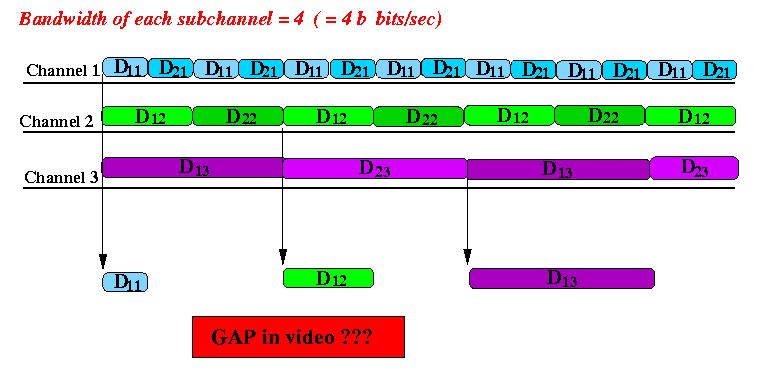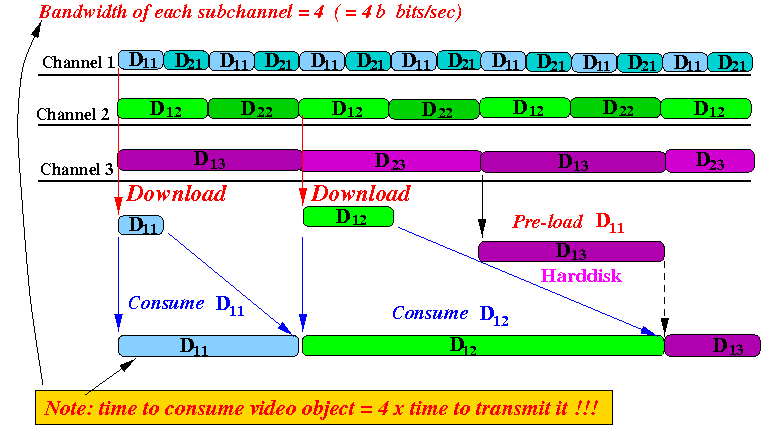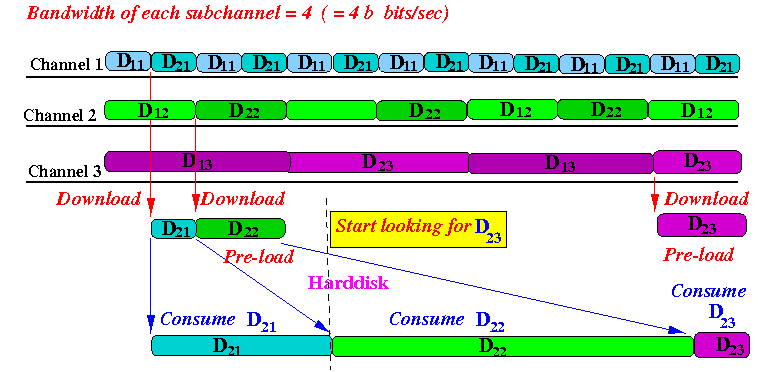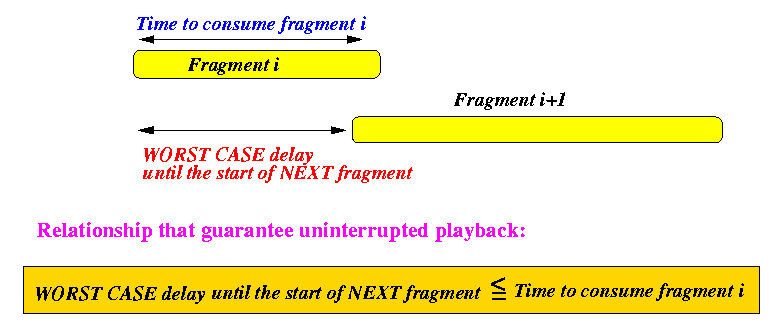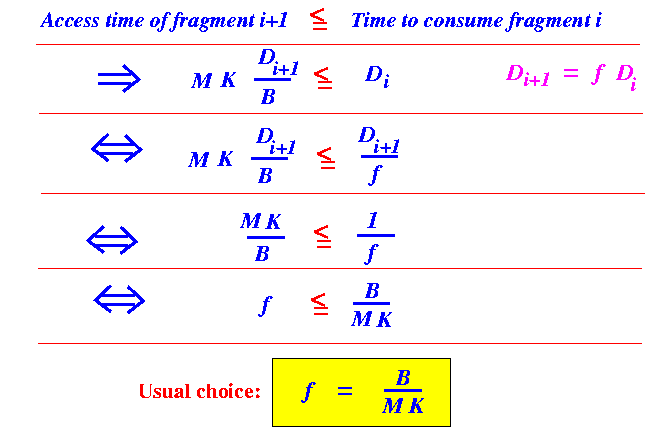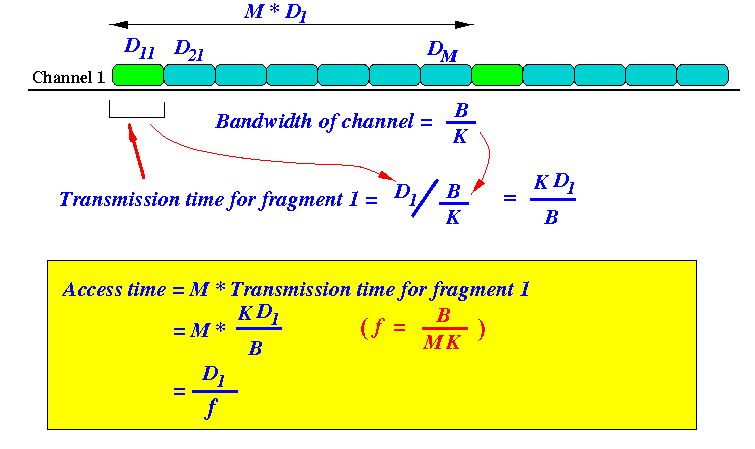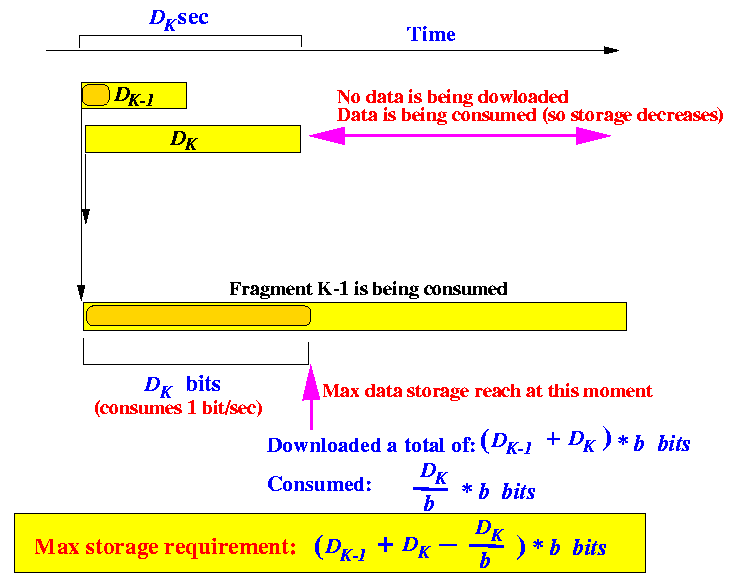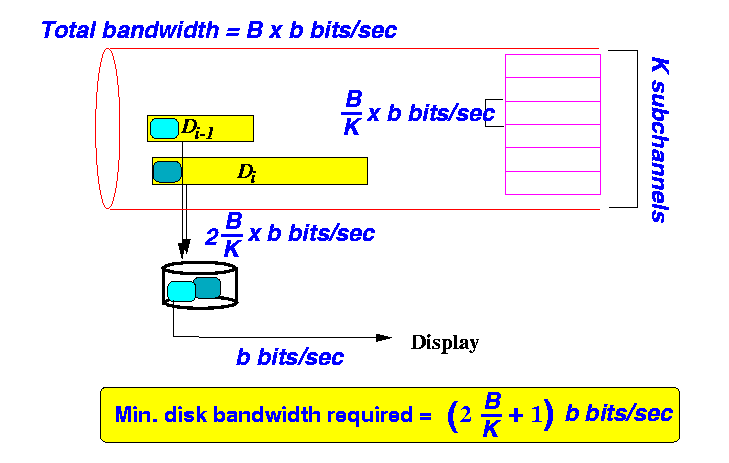- This material is not available from text books
- Reasearch paper: Pyramid Broadcasting for Video on Demand Service,
click here
- by: S. Viswanathan and T. Imielinski
- published in: Multimedia Systems, 1996
- Previously,
we saw previously that
Round Robin
broadcasting achieves an access time of:
- M = The number of video objects
- D = length of each video object (all video objects have same length), normalized to the consumption rate.
- B = The total amount bandwidth of channel, normalized to the consumption rate.
D Access Time(Round Robin) = M --- B - This access time was achieved in staggered and non-staggered
transmission - so staggering does not affect the access time
(it does affect the amount of data that the receiver must buffer)
- The Pyramid Broadcasting
technique was the
first technique
developed that can
reduce the access time
using the same system parameters
- Later techniques have been developed that improve on some shortcoming
of the Pyramid Broadcasting
technique, but nevertheless,
Pyramid Broadcasting
was the first to point this research to a whole new
direction.
- Recall the parameters of the Video on Demand system
in general:
- M = The number of video objects
- D = length of each video object (all video objects have same length), normalized to the consumption rate.
- B = The total amount bandwidth of channel, normalized to the consumption rate.
- The performance of the Pyramid Broadcasting
method depends very heavily on the following parameter.
The parameter K is the number of fragments that a video object will be divided into. - The larger the number of fragments
used, the
smaller the access time
becomes (i.e., users will see the video sooner.
- But larger fragments
will also require the receiver to use more buffer space
to store the video (for delayed replay)
- The following parameter
f
is defined as a
convenience
to explain
the Pyramid Broadcast
technique.
This parameter (f) is derived from the parameter K (number of fragments)
The parameter f will be explained later, for now, I will just simply tell you that:
B f = ---- MK - f
determines the size of the fragments used in
Pyramid Broadcast
- As you know, each video object is partitioned into
K
segments - but each segment has a different size !!!
- In fact, video objects are partititioned into
fragments of
increasing size
- The size of fragment
(i+1)th fragment
is determined as follows:
Di+1 = f * Di
where Di is the size of fragment i
- As you know, each video object is partitioned into
K
segments - but each segment has a different size !!!
- Finally, we have the "natural condition" that the sum
of all
K
fragments must be equal to the original
video (you don't want to lose some video :-)):
D1 + D2 + ... + DK = D
- Example:
Suppose:
- Number of video objects M = 2
- Size of each video object D = 700
- Total bandwidth B = 12
Suppose we select K = 3
Then, according to the formula above, we must divide each video object into this many segments:
B 12 f = ---- = ----- = 2 MK 3*2The following figure shows the division of one video object into K = 3 where each subsequent segment if f = 2 times as large as the previous one:
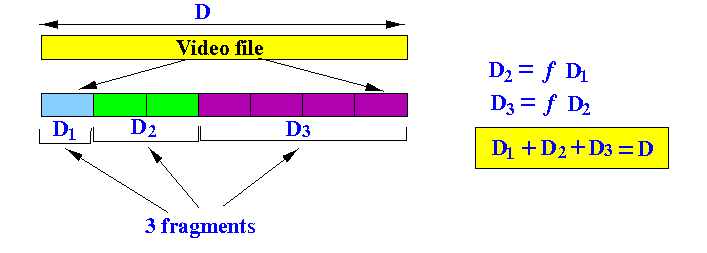
- Since:
- D2 = 2 * D1
- D3 = 2 * D2
- D1 + D2 + D3 = D
We have that:
- D1 + 2 D1 + 4 D1 = D
- Or:
7 D1 = D = 700
- So: D1 = 100
- And: D2 = 200
- And: D3 = 400
- The Pyramid Broadcasting method consists of:
- Transmission algorithm used by the sender
- Receive algorithm used by each receiver.
- Unlike the Round Robin Broadcasting method
that transmits the video object in
one single channel,
the Pyramid Broadcasting method
transmits
each fragment
in
one single channel
(And will therefore transmit the video object in K channels, since one video object is partitioned into K fragments)
- The transmission medium is partitioned into
K
channels
(Recall that K is the number of fragments.
Pyramid Broadcasting will send one fragment in each channel)
- NOTE::
-
A channel can be a multicast group
(e.g., on the Internet), but commonly,
it will be a channel on the cable or satelite network !
- Recall that:
- There are
M
video objects
- Each video object is partitioned into K fragments
- There are
M
video objects
- The fragments of the
M
video objects
are "distributed" over a number of channels in the
following manner:

- Channel 1
repeatedly transmits the
first fragment
D1
from all video objects,
over and over again
- Channel 2
repeatedly transmits the
second fragment
D2
from all video objects,
over and over again
- and so on...
- Channel K repeatedly transmits the last fragment DK from all video objects, over and over again
- Channel 1
repeatedly transmits the
first fragment
D1
from all video objects,
over and over again

